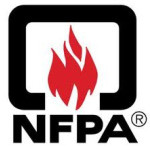- Settore: Fire safety
- Number of terms: 98780
- Number of blossaries: 0
- Company Profile:
Established in 1896, NFPA's mission is to reduce the worldwide burden of fire and other hazards on the quality of life by providing and advocating consensus codes and standards, research, training, and education.
A conductor required by some measures for protection against electric shock for electrically connecting any of the following parts: exposed conductive parts, extraneous conductive parts, or main (grounding) earthing terminal. Also identified in some instances as the protective external (PE) conductor.
Industry:Fire safety
A conductor or system of conductors arranged beneath the transmission/distribution supply line; located on, above, or most frequently below the surface of the earth; and connected to the grounding system of the towers or poles supporting the line. (This conductor(s) might or might not be the continuous length of the supply path. It is often used to provide a lower surge impedance path to earth for lightning protection when there is a transition from overhead supply conductors to underground insulated cable. ) Counterpoise is also used in communication systems, where it is a system of conductors, physically elevated above and insulated from the ground, forming a lower system of conductors of an antenna. Note that the purpose of a counterpoise is to provide a relatively high capacitance and thus a relatively low impedance path to earth. The counterpoise is sometimes used in medium-and low-frequency applications where it would be more difficult to provide an effective ground connection. Sometimes counterpoise is confused with equipotential plane. See also 3. 3. 26, Equipotential Plane.
Industry:Fire safety
A conductor intended to be used to carry lightning currents between strike termination devices and grounding electrodes.
Industry:Fire safety
A conductor having no covering or electrical insulation whatsoever.
Industry:Fire safety
A conductor from a lightning protection system to earth ground designed to provide a low impedance path for the current from a lightning strike and/or dissipate the charge buildup that precedes a lightning strike. This conductor typically goes from the air terminals to earth. Due to the very high currents at very high frequencies, the impedance of the entire system is very critical. Normal wiring conductors are not suitable for the down conductor. Typically, they are braided conductors. There might be certain instances where additional investigation about the interconnection between the lightning and the grounding electrode system is warranted.
Industry:Fire safety
A conductor encircling a structure that is used to interconnect grounding electrodes, main conductors, or other electrically conductive bodies.
Industry:Fire safety
A conductor encased within material of composition or thickness that is not recognized by this Codeas electrical insulation.
Industry:Fire safety
A conductor encased within material of composition and thickness that is recognized by this standard as electrical insulation.
Industry:Fire safety
A conducting object through which a direct connection to earth is established.
Industry:Fire safety
A conducting connection, whether intentional or accidental, between an electrical circuit or equipment and the earth, or to some conducting body that serves in place of the earth.
Industry:Fire safety
